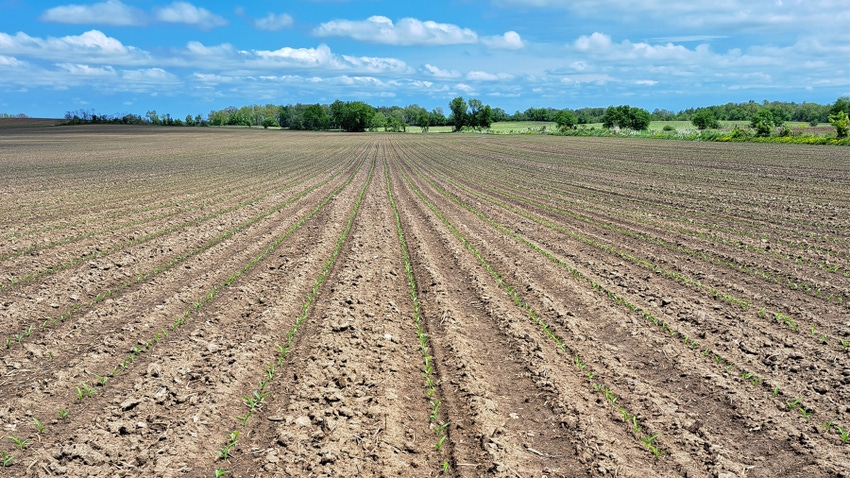February 15, 2023

by Natasha Paris
This time of year, we start to get excited about the coming growing season with its green fields. It can be easy to take the element that makes that gorgeous green for granted, yet this was not always the case.
Nitrogen is the most limiting nutrient in plant growth. While nitrogen may not have been formally identified as an element until 1772, its importance was understood long before then.
Early civilizations knew that manure improved the ground to grow better crops, and crop rotation was practiced throughout Europe, Asia and Africa. Every region had a pea, bean or clover that improved the yield of the crops that followed. Native Americans created an intercropping system called the “three sisters,” which consisted of beans, corn and squash planted together to share nutrients.
Nitrogen-fixing bacteria
When we look at a beautiful crop, we can see the evidence of nitrogen in the green growth, but what we don’t see are the massive amounts of nitrogen hanging in the air above every acre, waiting to have its potential unleashed. More nitrogen is present in the air than oxygen, but there’s a problem: That form of nitrogen is useless to plants.
Nitrogen in the air is in the form of N2, an extremely strong molecule with three bonds holding the nitrogen atoms tightly together. In the natural world, lightning was the only physical force that could break the bonds apart. Yet biology found a way to break those bonds in the form of nitrogen-fixing bacteria. That’s why legumes are so crucial to crop rotations; they form relationships with the bacteria that can pull nitrogen out of the air and make it usable for plants.
By the time nitrogen-fixing bacteria were identified in a lab in the 1880s, the world was already staring down a crisis. The Industrial Revolution and its accompanying changes in population and wealth led to the increased need for food. In 1798, Thomas Malthus predicted a mass die-off from our inability to produce enough food. Fortunately, Malthus has mostly been proven wrong, as our ability to feed the world has kept pace far beyond the expectations of thinkers from 200 years ago.
At first, this ability was due to the Spanish and the British taking advantage of resources they found elsewhere in the world in the form of bird guano, saltpeter and nitrate deposits, mostly in South America and India. Those deposits were quickly depleted by a hungry Europe and North America, and we were once again facing the possibility of not having enough nitrogen to grow food.
Chemistry stepped up next as scientists worked to find a way to mimic lightning or break apart nitrogen molecules in other ways. The breakthrough came in 1909 in Germany when Fritz Haber’s lab was able to produce 4 ounces of ammonia per hour from the air using very high pressure, heat and a catalyst like iron or uranium.
Carl Bosch at BASF managed to scale up the process, and in 1913 opened the first ammonia factory, which produced up to 20 tons per day. These factories have allowed for billions of people to be fed in the past century, to the point that half of the nitrogen in our bodies today is estimated to come from the Haber-Bosch process.
Fertilizer revolution
Unfortunately, there are no true miracles, and this revolution in fertilizer production has had its drawbacks. Plants are not very efficient at using nitrogen applied to the soil, and the excess nitrogen left behind tends to leach into our waterways, leading to issues such as algae blooms and nitrate contamination in groundwater, which is linked to health problems.
Also, the hydrogen needed to bond with nitrogen to form ammonia must come from somewhere. The most common source today is methane, also known as natural gas, a fossil fuel that adds carbon to the atmosphere when burned. In fact, the amount of natural gas consumed to make the fertilizer to grow 1 acre of corn could heat the average U.S. home for 20 days.
The vast amounts of nitrogen that surround us have proven to be anything but free. Today, agriculture is pursuing methods to reduce commercial nitrogen use using on-farm trials, split applications and legume rotations, or by attempting to create new paths of biological fixation for a wider variety of crops. It is easy today to take our endless acres of green crops for granted, but nitrogen’s story is complicated and will continue to be in the future.
To explore ways you can conserve nitrogen on your farm, contact your Extension regional crops educator.
Paris is a regional crops educator for the University of Wisconsin-Madison Division of Extension serving Green Lake, Marquette, Waushara and Adams counties.
You May Also Like




